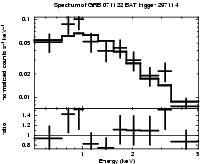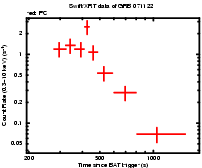- Home
- About
- Support
- Data Access
- Data Analysis
- Data Products
- Publications
-
Links
Databases NED Simbad GCN circulars archive GRB data table Software & Tools Swift Software (HEASoft) Xanadu WebPIMMS Institutional Swift Sites GSFC PSU OAB SSDC MSSL University of Leicester
SPER data products
SPER data are XRT Photon Counting (PC) mode data telemetered via TDRSS during Swift's first snapshot of a new BAT trigger. SPER data consists of all grade 0 (single pixel) events above 0.5 keV and within the central 200 x 200 pixel (approx 8x8 arcmin) window of the detector, and thus comprise a subset of the full dataset (hereafter "Malindi data"). Because of the limited information per event in the SPER data, special processing is required to make standard format products.
We have produced routines to search SPER data for sources, and centroid accurately on them; this was automated in 2007 May. Since 2007 August, GCN position notices have been automatically produced to disseminate the positions thus produced (see GCN Circ 6726 for more information). In 2008 February, this process was further improved by using promptly available UVOT data to 'enhance' those positions for which this is possible, reducing the systematic uncertainty. Full details are given on the SPER position documentation page.
We have also created software to automatically extract light curves and spectra from the SPER data, giving early indications of a GRB's properties within minutes of a trigger. If the absorption column can be constrained, we are able to give upper limits on the GRB redshift. Details of these products are given below.
Spectra and redshift limits

Spectra are automatically extracted from SPER data using the source and
background regions determined so as to avoid pile-up and maximum signal-to-noise
(see Evans et al. 2007,
2009
for details). Exposure maps and effective area
(arf) files are also created, and the spectra automatically fitted using
xspec. Fitting is performed using the C-statistic.
Spectra are fitted with a model comprising a photoelectric absorber fixed at the Galactic value (from Kalberla et al. 2005, obtained using the nh FTOOL), a zero-redshift second absorber for which NH is free to vary, and a power-law with both slope and normalisation free. If the lower limit on the free absorber is non-zero, the nH-redshift-limit relation from Grupe et al. 2007 is used to determine an upper limit on the redshift for this GRB. Finally, the spectral parameters, any redshift limit and a plot of the fit are published on the SPER results pages. If the redshift limit is higher than 5 it is not reported since it is of no real value. Also, since the data used by Grupe et al. contain few points at low redshifts, if the redshift limit is lower than two we simply report z<2.Note that, even when an upper limit on redshift is determined using spectra and the Grupe relation it is still possible that the burst lies at a high redshift, if the absorption column is anomalously high -- at least 3—10 times higher than the largest column constrained by the XRT for a GRB afterglow to date.
Verification
To confirm that our spectra give accurate results, we compared the automatically fitted absorption columns with those given in the GCN Circulars. We found good, but less than 90%, agreement within the 90% confidence errors. The level of agreement was increased if we fitted the auto-generated spectra manually, demonstrating that occasionally, the auto fit finds a local mininum, however the SPER data still agreed with the Malindi data less than 90% of the time. This may reflect spectral evolution in the GRB, since the values given in the GCN typically cover different time intervals to the SPER data. We thus chose a small sample of GRBs, and manually created spectra from the Malindi data, choosing temporal ranges identical to those in the SPERs, fitted them with an absorbed power law, and compared this to the automated SPER results. This time we found >90% agreement. We performed the same tests on the photon index, with similar results.
NOTE Because the automatic spectral fitting occasionally settles on a local minimum, the XRT team will always manually verify the spectral fit before quoting values in a GCN circular. These web pages are updated when the XRT team inputs the true best-fitting values.
There are 12 GRBs with both spectroscopic redshifts for which out auto processing products a redshift upper limit. For 11 of these, the upper limit is higher than the measured redshift, i.e. is reliable. For the other burst, the automatic fitting gave an innaccuate result: manually fitting fit automatically generated data, we found a redshift limit consistent with the spectroscopic value.
Light curves

Automated light curve production for GRBs using the full Malindi dataset is described in detail in Evans et al. (2007, 2009) and on the light curve documentation page. Light curve production from SPER data is almost identical with the following caveats:
- No GTI information is available, so the fractional exposure is assumed to be 1. This is likely to be a good assumption.
- A single source region is used for the whole dataset. So, for example, if the data are piled up at any point, an annulus is used for the whole SPER, which was reduce the signal to noise of the data a little. While the inner radius of the annulus is calculated from data only during times of pile up, the outer radius (or the radius of the circle if there is no pile up) is based on the mean count rate for the entire exposure.
Note also that, as SPER data contain less events than the Malindi data, the temporal resolution of SPER light curves is lower than in "normal" curves.
Verification
The entire catalogue of SPER light curves has been compared to the Malindi light curves from the light curve repository, and their accuracy thus verified.
